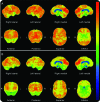Frontotemporal brain sagging syndrome: an SIH-like presentation mimicking FTD
- PMID: 21502595
- PMCID: PMC3087405
- DOI: 10.1212/WNL.0b013e3182166e42
Frontotemporal brain sagging syndrome: an SIH-like presentation mimicking FTD
Abstract
Background: Behavioral variant frontotemporal dementia (bvFTD) is a relatively well-defined clinical syndrome. It is associated with frontal and temporal lobe structural/metabolic changes and pathologic findings of a neurodegenerative disease. We have been evaluating patients with clinical and imaging features partially consistent with bvFTD but with evidence also suggestive of brain sagging, which we refer to as frontotemporal brain sagging syndrome (FBSS).
Methods: Retrospective medical chart review to identify all patients seen at our institution between 1996 and 2010, who had a clinical diagnosis of FTD and imaging evidence of brain sag.
Results: Eight patients, 7 male and 1 female, were diagnosed with FBSS. The median age at symptom onset was 53 years. All patients had insidious onset and slow progression of behavioral and cognitive dysfunction accompanied by daytime somnolence and headache. Of the 5 patients with functional imaging, all showed evidence of hypometabolism of the frontotemporal regions. On brain MRI, all patients had evidence of brain sagging with distortion of the brainstem; 3 patients had diffuse pachymeningeal enhancement. CSF opening pressure was varied and CSF protein was mildly elevated. A definite site of CSF leak was not identified by myelogram or cisternography, except in one patient with a site highly suggestive of leak who subsequently underwent surgery confirming a CSF leak. In 2 patients with a neuropathologic examination, there was no evidence of a neurodegenerative disease.
Conclusions: This case series demonstrates that FBSS may mimic typical bvFTD but should be recognized as an unusual presentation that is potentially treatable.
Figures


Comment in
-
Uplifting news for frontotemporal dementia: The sagging brain syndrome.Neurology. 2011 Apr 19;76(16):1370-1. doi: 10.1212/WNL.0b013e3182167175. Neurology. 2011. PMID: 21502594 No abstract available.
References
-
- Neary D, Snowden JS, Gustafson L, et al. Frontotemporal lobar degeneration: a consensus on clinical diagnostic criteria. Neurology 1998;51:1546–1554 - PubMed
-
- McKhann G, Albert M, Grossman M, et al. Clinical and pathological diagnosis of frontotemporal dementia: report of the work group on frontotemporal dementia and Pick's disease. Arch Neurol 2001;58:1803–1809 - PubMed
-
- Munoz D, Dickson D, Bergeron C, et al. The neuropathology and biochemistry of frontotemporal dementia. Ann Neurol 2003;54:S24–S28 - PubMed
-
- Josephs K. Frontotemporal dementia and related disorders: deciphering the enigma. Ann Neurol 2008;64:4–14 - PubMed
Publication types
MeSH terms
Substances
LinkOut - more resources
Full Text Sources
Other Literature Sources
